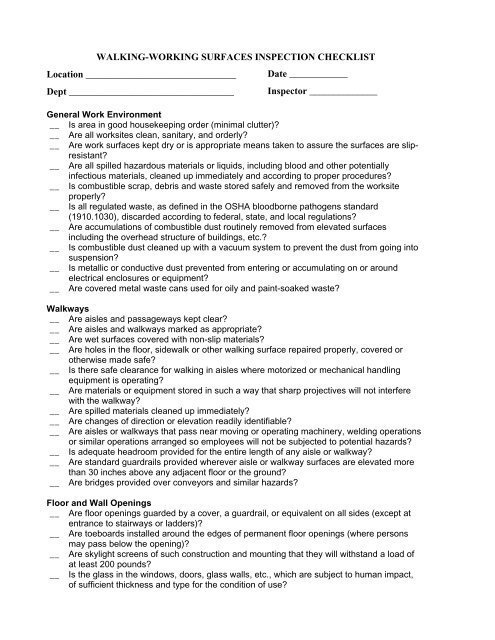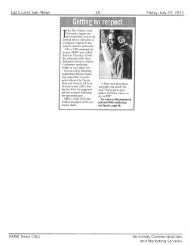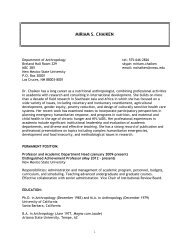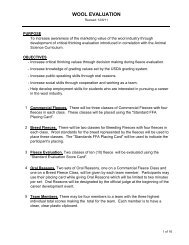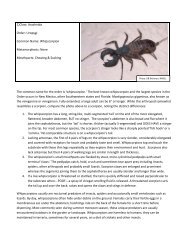Inspection Checklist for WALKING-WORKING SURFACES
Inspection Checklist for WALKING-WORKING SURFACES
Inspection Checklist for WALKING-WORKING SURFACES
You also want an ePaper? Increase the reach of your titles
YUMPU automatically turns print PDFs into web optimized ePapers that Google loves.
<strong>WALKING</strong>-<strong>WORKING</strong> <strong>SURFACES</strong> INSPECTION CHECKLIST<br />
Location _______________________________<br />
Dept __________________________________<br />
Date ____________<br />
Inspector ______________<br />
General Work Environment<br />
__ Is area in good housekeeping order (minimal clutter)?<br />
__ Are all worksites clean, sanitary, and orderly?<br />
__ Are work surfaces kept dry or is appropriate means taken to assure the surfaces are slipresistant?<br />
__ Are all spilled hazardous materials or liquids, including blood and other potentially<br />
infectious materials, cleaned up immediately and according to proper procedures?<br />
__ Is combustible scrap, debris and waste stored safely and removed from the worksite<br />
properly?<br />
__ Is all regulated waste, as defined in the OSHA bloodborne pathogens standard<br />
(1910.1030), discarded according to federal, state, and local regulations?<br />
__ Are accumulations of combustible dust routinely removed from elevated surfaces<br />
including the overhead structure of buildings, etc.?<br />
__ Is combustible dust cleaned up with a vacuum system to prevent the dust from going into<br />
suspension?<br />
__ Is metallic or conductive dust prevented from entering or accumulating on or around<br />
electrical enclosures or equipment?<br />
__ Are covered metal waste cans used <strong>for</strong> oily and paint-soaked waste?<br />
Walkways<br />
__ Are aisles and passageways kept clear?<br />
__ Are aisles and walkways marked as appropriate?<br />
__ Are wet surfaces covered with non-slip materials?<br />
__ Are holes in the floor, sidewalk or other walking surface repaired properly, covered or<br />
otherwise made safe?<br />
__ Is there safe clearance <strong>for</strong> walking in aisles where motorized or mechanical handling<br />
equipment is operating?<br />
__ Are materials or equipment stored in such a way that sharp projectives will not interfere<br />
with the walkway?<br />
__ Are spilled materials cleaned up immediately?<br />
__ Are changes of direction or elevation readily identifiable?<br />
__ Are aisles or walkways that pass near moving or operating machinery, welding operations<br />
or similar operations arranged so employees will not be subjected to potential hazards?<br />
__ Is adequate headroom provided <strong>for</strong> the entire length of any aisle or walkway?<br />
__ Are standard guardrails provided wherever aisle or walkway surfaces are elevated more<br />
than 30 inches above any adjacent floor or the ground?<br />
__ Are bridges provided over conveyors and similar hazards?<br />
Floor and Wall Openings<br />
__ Are floor openings guarded by a cover, a guardrail, or equivalent on all sides (except at<br />
entrance to stairways or ladders)?<br />
__ Are toeboards installed around the edges of permanent floor openings (where persons<br />
may pass below the opening)?<br />
__ Are skylight screens of such construction and mounting that they will withstand a load of<br />
at least 200 pounds?<br />
__ Is the glass in the windows, doors, glass walls, etc., which are subject to human impact,<br />
of sufficient thickness and type <strong>for</strong> the condition of use?
__ Are grates or similar type covers over floor openings such as floor drains of such design<br />
that foot traffic or rolling equipment will not be affected by the grate spacing?<br />
__ Are unused portions of service pits and pits not actually in use either covered or protected<br />
by guardrails or equivalent?<br />
__ Are manhole covers, trench covers and similar covers, plus their supports designed to<br />
carry a truck rear axle load of at least 20,000 pounds when located in roadways and<br />
subject to vehicle traffic?<br />
__ Are floor or wall openings in fire resistive construction provided with doors or covers<br />
compatible with the fire rating of the structure and provided with a self-closing feature<br />
when appropriate?<br />
Stairs and Stairways<br />
__ Are standard stair rails or handrails on all stairways having four or more risers?<br />
__ Are all stairways at least 22 inches wide?<br />
__ Do stairs have landing plat<strong>for</strong>ms not less than 30 inches in the direction of travel and<br />
extend 22 inches in width at every 12 feet or less of vertical rise?<br />
__ Do stairs angle no more than 50 and no less than 30 degrees?<br />
__ Are step risers on stairs uni<strong>for</strong>m from top to bottom?<br />
__ Are steps on stairs and stairways designed or provided with a surface that renders them<br />
slip resistant?<br />
__ Are stairway handrails located between 30 and 34 inches above the leading edge of stair<br />
treads?<br />
__ Do stairway handrails have at least 3 inches of clearance between the handrails and the<br />
wall or surface they are mounted on?<br />
__ Where doors or gates open directly on a stairway, is there a plat<strong>for</strong>m provided so the<br />
swing of the door does not reduce the width of the plat<strong>for</strong>m to less than 21 inches?<br />
__ Where stairs or stairways exit directly into any area where vehicles may be operated, are<br />
adequate barriers and warnings provided to prevent employees stepping into the path of<br />
traffic?<br />
__ Do stairway landings have a dimension measured in the direction of travel, at least equal<br />
to the width of the stairway?<br />
Elevated Surfaces<br />
__ Are signs posted, when appropriate, showing the elevated surface load capacity?<br />
__ Are surfaces elevated more than 30 inches above the floor or ground provided with<br />
standard guardrails?<br />
__ Are all elevated surfaces (beneath which people or machinery could be exposed to falling<br />
objects) provided with standard 4-inch toeboards?<br />
__ Is a permanent means of access and egress provided to elevated storage and work<br />
surfaces?<br />
__ Is required headroom provided where necessary?<br />
__ Is material on elevated surfaces piled, stacked or racked in a manner to prevent it from<br />
tipping, falling, collapsing, rolling or spreading?<br />
__ Are dock boards or bridge plates used when transferring materials between docks and<br />
trucks or rail cars?


